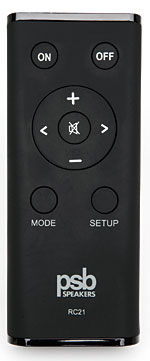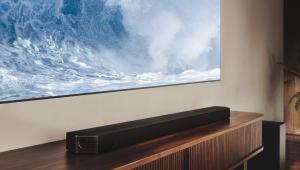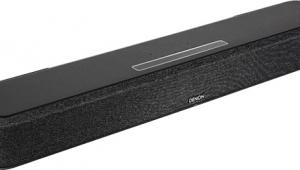PSB Alpha VS21 VisionSound Soundbase and SubSeries 150 Subwoofer Review Page 2
Lord of the Tones
The VS21 is voiced to sound like PSB’s loudspeakers and headphones. In other words, it sounds superb, with a well-controlled top end, creamy mids, and reasonably substantial bass from the 4-inch woofers. (Some products this size try to get it all done with drivers no larger than 2 inches, which has obvious limitations.) I briefly tried the WideSound mode with test tones from the AVIA test disc and found that the system doesn’t even attempt to approximate surround effects; it focuses more on front width, as the name suggests. The SubSeries 150 firmed up the bottom end and had plenty of output in my room. There was so much line-level gain that I never set its volume knob higher than the 9 o’clock mark, and sometimes lower.
Following a recent train of thought, I pulled the middle volume of Lord of the Rings (DVD, Dolby Digital) off the shelf. In addition to providing some practical life lessons—never mess with the Ents, those giant tree people, or you’ll get stomped— The Two Towers showed off the WideSound mode to good effect.

In an early scene where Gollum stalks Frodo and Sam in the rain, the surround mode widened the soundstage about a foot or so from each side of the base. The effect was subtle but pleasing. With aggressively dynamic battle and other scenes, I spent a lot of time in the WideSound Plus (surround plus dialogue) mode. Again, the effect was subtle but helpful. PSB has clearly decided to make both WideSound and Dialogue compatible with decent fidelity. You can use one, the other, both, or neither, and you’ll still end up with extremely palatable sound. If you leave one mode or the other engaged and forget about it, no harm done. PSB has banished any possibility of improper settings causing bad sound from this product.
If you feed your HD or UHDTV with Blu-ray Discs, you’ll often be listening to lossless soundtracks downmixed to stereo. I watched Ouija with the Oppo downmixing the disc’s soundtrack from both 5.1 DTS and 2.0 Dolby Digital. It didn’t seem to make any difference; the dialogue was plenty clear either way. When the screaming started, I appreciated PSB’s disciplined approach to the upper mids and highs.
The best movie ever made about a symphony is Eroica, with Ian Hart as Beethoven and featuring a vibrant, complete (albeit dramatically interrupted) performance of the Third Symphony by the Orchestre Rèvolutionnaire et Romantique (conducted off-camera by John Eliot Gardiner). Here, I simply selected stereo PCM from the disc menu. An early scene with dialogue and birdsong showed off the WideSound mode’s ability to break free of the unit. Two listening firsts: I spent five minutes listening on an exercise bike, placing me above and to the left of the prime listening position. Imaging suffered, but tonal balance held firm. And, for the first time, a soundbase drew both a smile and tears— the former, when a reactionary nobleman said, “It may not be music at all,” and the latter, at the very end, when elderly Papa Haydn summed up Beethoven’s heroic symphony: “Everything is different from today.”
 The Dialogue Exception
The Dialogue Exception
More Beethoven! On The Beethoven Journey (CD), a recording of Piano Concertos Nos. 1 and 3, Leif Ove Andsnes leads the Mahler Chamber Orchestra from behind the keyboard. I’ve actually paid a visit to the recording venue, Prague’s Rudolfinum, one of the world’s best-sounding concert halls. While the WideSound mode didn’t quite conjure up the feeling of being there—including the hall’s voluptuous decay—the VS21 did approximate the tonal balance of an orchestra playing there. It was quite un-beamy, too. I could move around the sofa, or the room, and the system retained its musical power.
Richard Thompson’s Still (CD) is an album that begs to be played all the way through (so I’m Still playing it). Taras Prodaniuk’s bass is a powerful and integral part of Thompson’s live trio, and the SubSeries 150 provided the low-frequency oomph necessary to at least hint at the bassist’s deep weight and supple force. The WideSound mode made the mix seem not only wider but timbrally livelier, at least in this selection.
While I didn’t apply the Dialogue mode to most of the music I auditioned, Madeleine Peyroux’s Careless Love (CD) was a notable exception. Larry Klein’s alwaysexcellent production steadfastly avoids reverb, delivering everything in a clean, flat, spartan style. But I yearned to better hear Peyroux’s Billie Holiday–like voice, and what better way to accomplish that than with PSB’s scrupulously subtle Dialogue mode? It floated the lead vocal a little above the instruments—just what I needed.
I watched a lot of TV while the PSB was in residence, including the first week of The Late Show with Stephen Colbert. The Dialogue mode did a good job of keeping speaking voices intelligible at a volume level appropriate for midnight-hour TV watching. The house band, Stay Human with Jon Batiste, was better served by the WideSound Plus combo mode.
There are several features I’d like to see added to this product. Chief among them are front-panel controls, which adds convenience and avoids disabling the unit from a misplaced remote. Next on the list of priorities, a volume indicator would give listeners a better sense of how close they’re getting to the system’s limits. Finally, and least significantly, bass and treble controls would give users more tweakability and provide for some variability of tonal balance among different source material. Beyond this, there’s this unit’s price to consider (both with or without the sub) given its potential restriction to smaller TVs.
That said, it’s noteworthy that the full name of the PSB Alpha VS21 VisionSound includes Alpha, the longtime name of PSB’s affordable but high-performing loudspeaker line. The company is essentially saying that this product isn’t just a convenient compromise or a necessary evil; it is, in fact, an honored part of a fabled speaker line, and it measures up to the high standards that PSB has upheld for many years. I’d have to agree. VisionSound isn’t just a great soundbase. It’s a great audio product, period.


























































